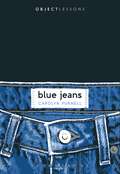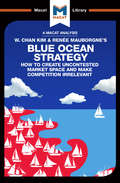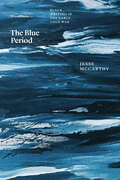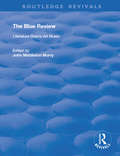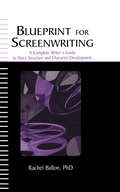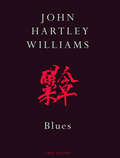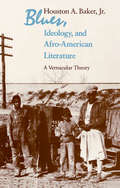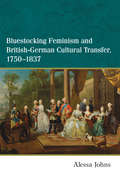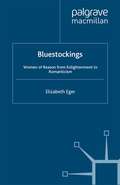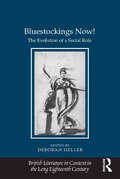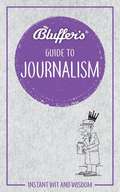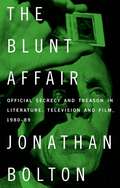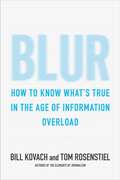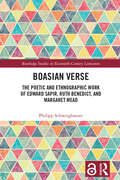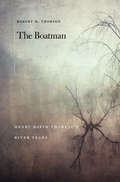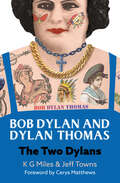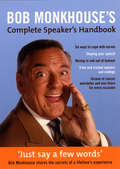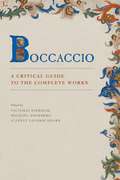- Table View
- List View
Blue Jeans (Object Lessons)
by Carolyn PurnellObject Lessons is a series of short, beautifully designed books about the hidden lives of ordinary things.Few clothing items are as ubiquitous or casual as blue jeans. Yet, their simplicity is deceptive. Blue jeans are nothing if not an exercise in opposites. Americans have accepted jeans as a symbol of their culture, but today jeans are a global consumer product category. Levi Strauss made blue jeans in the 1870s to withstand the hard work of mining, but denim has since become the epitome of leisure. In the 1950s, celebrities like Marlon Brando transformed the utilitarian clothing of industrial labor into a glamorous statement of youthful rebellion, and now, you can find jeans on chic fashion runways. For some, indigo blue might be the color of freedom, but for workers who have produced the dye, it has often been a color of oppression and tyranny. Blue Jeans considers the versatility of this iconic garment and investigates what makes denim a universal signifier, ready to fit any context, meaning, and body.Object Lessons is published in partnership with an essay series in The Atlantic.
Blue Ocean Strategy: How to Create Uncontested Market Space (The Macat Library)
by Andreas Mebert Stephanie LoweIn Blue Ocean Strategy, W. Chan Kim and Renée Mauborgne tackle the central problem facing all businesses: how to perform better than your competitors? Their solution involves taking a creative approach to the normal view of competition. In the normal framework, competition is a zero-sum game: if there are two companies competing for the same market, as one does better, the other has to do worse. The authors’ creative leap is to suggest one can beat the competition by not competing. Companies should avoid confronting competitors in crowded marketplaces, what they call “red oceans,” and instead seek out new markets, or “blue oceans.” Once the blue oceans have been identified, companies can get down to the task of creating unique products which exploit that market. Chan and Mauborgne argue, for example, that a wine company might decide to start appealing to a group previously uninterested in wine. This would be a “blue ocean” market, giving the winemaker a huge advantage, which they could exploit by creating a wine that appealed to the tastes of a beer-drinking demographic. A classic of business writing, Blue Ocean Strategy is creative thinking and problem solving at its best.
The Blue Period: Black Writing in the Early Cold War (Thinking Literature)
by Jesse McCarthyAddresses the political and aesthetic evolution of African American literature and its authors during the Cold War, an era McCarthy calls “the Blue Period.” In the years after World War II, to be a black writer was to face a stark predicament. The contest between the Soviet Union and the United States was a global one—an ideological battle that dominated almost every aspect of the cultural agenda. On the one hand was the Soviet Union, espousing revolutionary communism that promised egalitarianism while being hostile to conceptions of personal freedom. On the other hand was the United States, a country steeped in racial prejudice and the policies of Jim Crow. Black writers of this time were equally alienated from the left and the right, Jesse McCarthy argues, and they channeled that alienation into remarkable experiments in literary form. Embracing racial affect and interiority, they forged an aesthetic resistance premised on fierce dissent from both US racial liberalism and Soviet communism. From the end of World War II to the rise of the Black Power movement in the 1960s, authors such as Richard Wright, James Baldwin, Gwendolyn Brooks, and Paule Marshall defined a distinctive moment in American literary culture that McCarthy terms the Blue Period. In McCarthy’s hands, this notion of the Blue Period provides a fresh critical framework that challenges long-held disciplinary and archival assumptions. Black writers in the early Cold War went underground, McCarthy argues, not to depoliticize or liberalize their work, but to make it more radical—keeping alive affective commitments for a future time.
The Blue Period: Black Writing in the Early Cold War (Thinking Literature)
by Jesse McCarthyAddresses the political and aesthetic evolution of African American literature and its authors during the Cold War, an era McCarthy calls “the Blue Period.” In the years after World War II, to be a black writer was to face a stark predicament. The contest between the Soviet Union and the United States was a global one—an ideological battle that dominated almost every aspect of the cultural agenda. On the one hand was the Soviet Union, espousing revolutionary communism that promised egalitarianism while being hostile to conceptions of personal freedom. On the other hand was the United States, a country steeped in racial prejudice and the policies of Jim Crow. Black writers of this time were equally alienated from the left and the right, Jesse McCarthy argues, and they channeled that alienation into remarkable experiments in literary form. Embracing racial affect and interiority, they forged an aesthetic resistance premised on fierce dissent from both US racial liberalism and Soviet communism. From the end of World War II to the rise of the Black Power movement in the 1960s, authors such as Richard Wright, James Baldwin, Gwendolyn Brooks, and Paule Marshall defined a distinctive moment in American literary culture that McCarthy terms the Blue Period. In McCarthy’s hands, this notion of the Blue Period provides a fresh critical framework that challenges long-held disciplinary and archival assumptions. Black writers in the early Cold War went underground, McCarthy argues, not to depoliticize or liberalize their work, but to make it more radical—keeping alive affective commitments for a future time.
The Blue Review: Literature Drama Art Music Numbers One to Three, May 1913 - July 1913 (Routledge Revivals)
by John Middleton MurryOriginally published in 1913, this volume contains the full text of editions one, two and three of The Blue Review – the magazine of literature, drama, art and music - from May 1913 to July 1913.
The Blue Review: Literature Drama Art Music Numbers One to Three, May 1913 - July 1913 (Routledge Revivals)
by John Middleton MurryOriginally published in 1913, this volume contains the full text of editions one, two and three of The Blue Review – the magazine of literature, drama, art and music - from May 1913 to July 1913.
Blueprint for Screenwriting: A Complete Writer's Guide to Story Structure and Character Development
by Rachel BallonBlueprint for Screenwriting demystifies the writing process by developing a "blueprint" for writers to follow for each new screenplay--from original concept to completed script. Author and international script consultant Dr. Rachel Ballon explores the writing craft and emphasizes creativity in the writing process. She blends her expertise in script analysis and writing coaching with her personal experience as a screenwriter to help writers construct their stories and characters.Starting with the story's framework, Dr. Ballon helps readers to understand the key "building blocks" of story structure and character development, including characters' emotional and psychological states, story conflicts, and scene and act structure. She also covers the essential components in the script writing process, such as outlines, script treatments, synopses, and formats. Dr. Ballon devotes a chapter to overcoming writer's block--the writer's greatest obstacle--and offers guidance for taking the next steps once a script is completed.A practical tool for any writer, this distinctive resource:*offers a blueprint for writers to follow, breaking the writing process down into specific, easy-to-follow steps;*stresses the psychology of the characters as well as that of the writer; and*offers first-hand knowledge of the screenwriting process and gives practical advice for completing and marketing scripts.With its unique and insightful approach to the writing process, this book will be indispensable for scriptwriters, fiction writers, and professional writers, and it will serve as a useful text in screenwriting courses.
Blueprint for Screenwriting: A Complete Writer's Guide to Story Structure and Character Development
by Rachel BallonBlueprint for Screenwriting demystifies the writing process by developing a "blueprint" for writers to follow for each new screenplay--from original concept to completed script. Author and international script consultant Dr. Rachel Ballon explores the writing craft and emphasizes creativity in the writing process. She blends her expertise in script analysis and writing coaching with her personal experience as a screenwriter to help writers construct their stories and characters.Starting with the story's framework, Dr. Ballon helps readers to understand the key "building blocks" of story structure and character development, including characters' emotional and psychological states, story conflicts, and scene and act structure. She also covers the essential components in the script writing process, such as outlines, script treatments, synopses, and formats. Dr. Ballon devotes a chapter to overcoming writer's block--the writer's greatest obstacle--and offers guidance for taking the next steps once a script is completed.A practical tool for any writer, this distinctive resource:*offers a blueprint for writers to follow, breaking the writing process down into specific, easy-to-follow steps;*stresses the psychology of the characters as well as that of the writer; and*offers first-hand knowledge of the screenwriting process and gives practical advice for completing and marketing scripts.With its unique and insightful approach to the writing process, this book will be indispensable for scriptwriters, fiction writers, and professional writers, and it will serve as a useful text in screenwriting courses.
Blues
by John Hartley WilliamsSubversive and satirical, inventive, wry and unconventional, John Hartley Williams has long been celebrated for his maverick sensibility, for his outsider's take on the way we live our lives. In Blues, his eighth collection, he focuses with new directness on the turmoil of Germany and Eastern Europe, and writes eloquently about being English, and staying English, in a continental climate, through all the upheavals of the last fifteen years. Alert to the intricacies and ironies of the language, to the musculature of politics and passion, these poems are chronicles of change, wired to the energies of jazz and science fiction, yet the under-song is a threnody for the loss of a kind of Englishness - voiced powerfully in a moving elegy for the poet Ken Smith. While there is no diminishing of his comic brio, no dulling of his incisive, questioning intelligence, Blues finds John Hartley Williams taking on subjects of new depth and complexity - while maintaining his characteristic lightness of touch, imagination and profound originality.
Blues, Ideology, and Afro-American Literature: A Vernacular Theory
by Houston A. Baker, Jr.Relating the blues to American social and literary history and to Afro-American expressive culture, Houston A. Baker, Jr., offers the basis for a broader study of American culture at its "vernacular" level. He shows how the "blues voice" and its economic undertones are both central to the American narrative and characteristic of the Afro-American way of telling it.
Bluestocking Feminism and British-German Cultural Transfer, 1750-1837
by Alessa JohnsBluestocking Feminism and British-German Cultural Transfer, 1750–1837 examines the processes of cultural transfer between Britain and Germany during the Personal Union, the period from 1714 to 1837 when the kings of England were simultaneously Electors of Hanover. While scholars have generally focused on the political and diplomatic implications of the Personal Union, Alessa Johns offers a new perspective by tracing sociocultural repercussions and investigating how, in the period of the American and French Revolutions, Britain and Germany generated distinct discourses of liberty even though they were nonrevolutionary countries. British and German reformists—feminists in particular—used the period’s expanded pathways of cultural transfer to generate new discourses as well as to articulate new views of what personal freedom, national character, and international interaction might be. Johns traces four pivotal moments of cultural exchange: the expansion of the book trade, the rage for translation, the effect of revolution on intra-European travel and travel writing, and the impact of transatlantic journeys on visions of reform. Johns reveals the way in which what she terms “bluestocking transnationalism” spawned discourses of liberty and attempts at sociocultural reform during this period of enormous economic development, revolution, and war.
Bluestockings: Women of Reason from Enlightenment to Romanticism (Palgrave Studies in the Enlightenment, Romanticism and Cultures of Print)
by E. EgerThis studyargues that female networks of conversation, correspondenceand patronage formed the foundation for women's work in the 'higher' realms of Shakespeare criticism and poetry. Eger traces the transition between Enlightenment and Romantic culture, arguing for the relevance of rational argument in the history of women's writing.
Bluestockings Now!: The Evolution of a Social Role (British Literature in Context in the Long Eighteenth Century)
by Deborah HellerBringing together top specialists in the field, this edited volume challenges the theory that the eighteenth-century British intellectual women known as the Bluestockings were an isolated phenomenon spanning the period from the 1750s through the 1790s. On the contrary, the contributors suggest, the Bluestockings can be conceptualized as belonging to a chain of interconnected networks, taking their origin at a threshold moment in print media and communications development and extending into the present. The collection begins with a definition of the Bluestockings as a social role rather than a fixed group, a movement rather than a static phenomenon, an evolving dynamic reaching into our late-modern era. Essays include a rare transcript of a Bluestocking conversation; new, previously unknown Bluestockings brought to light for the first time; and descriptions of Bluestocking activity in the realms of natural history, arts and crafts, theatre, industry, travel, and international connections. The concluding essay argues that the Blues reimagined and practiced women’s work in ways that adapted to and altered the course of modernity, decisively putting a female imprint on economic, social, and cultural modernization. Demonstrating how the role of the Bluestocking has evolved through different historical configurations yet has structurally remained the same, the collection traces the influence of the Blues on the Romantic Period through the nineteenth century and proposes the reinvention of Bluestocking practice in the present.
Bluestockings Now!: The Evolution of a Social Role (British Literature in Context in the Long Eighteenth Century)
by Deborah HellerBringing together top specialists in the field, this edited volume challenges the theory that the eighteenth-century British intellectual women known as the Bluestockings were an isolated phenomenon spanning the period from the 1750s through the 1790s. On the contrary, the contributors suggest, the Bluestockings can be conceptualized as belonging to a chain of interconnected networks, taking their origin at a threshold moment in print media and communications development and extending into the present. The collection begins with a definition of the Bluestockings as a social role rather than a fixed group, a movement rather than a static phenomenon, an evolving dynamic reaching into our late-modern era. Essays include a rare transcript of a Bluestocking conversation; new, previously unknown Bluestockings brought to light for the first time; and descriptions of Bluestocking activity in the realms of natural history, arts and crafts, theatre, industry, travel, and international connections. The concluding essay argues that the Blues reimagined and practiced women’s work in ways that adapted to and altered the course of modernity, decisively putting a female imprint on economic, social, and cultural modernization. Demonstrating how the role of the Bluestocking has evolved through different historical configurations yet has structurally remained the same, the collection traces the influence of the Blues on the Romantic Period through the nineteenth century and proposes the reinvention of Bluestocking practice in the present.
Bluffer's Guide to Journalism (Bluffer's Guides)
by Haynes UkIt isn't that journalism is particularly difficult - one look at Piers Morgan will prove that any fool can do it - but it nonetheless requires a level of braggadocio and bluster that would make even Donald Trump blush. It is possible to bluff one's way through discussions on wine, or Brexit, or even the offside rule, with a little knowledge and a bit of brass neck. But anyone who attempts to pull the wool over the eyes of a journalist will be attempting The Greatest Bluff Known To Humankind, because journalists can smell a lie from 500 miles away down a patchy telephone line, while drunk and at closing time. To pull it off, you will need the native cunning of Machiavelli, the coolness of Dean Martin and the same total lack of scruples as Del Boy Trotter. You will also need this book.
The Blunt Affair: Official secrecy and treason in literature, television and film, 1980–89
by Jonathan BoltonThe case of the Cambridge spies has long captured the public’s attention, but perhaps never more so than in the wake of Anthony Blunt’s exposure as the fourth man in November 1979. With the Cold War intensifying, patriotism running high during the Falklands War and the AIDS crisis leading to widespread homophobia, these notorious traitors were more relevant than ever. This book explores how they were depicted in literature, television and film throughout the 1980s. Examining works by an array of distinguished writers, including Dennis Potter, Alan Bennett, Tom Stoppard and John le Carré, it sheds new light on the affair, asking why such privileged young men chose to betray their country, whether loyalty to one’s friends is more important than patriotism and whether we can really trust the intelligence services.
The Blunt Affair: Official secrecy and treason in literature, television and film, 1980–89
by Jonathan BoltonThe case of the Cambridge spies has long captured the public’s attention, but perhaps never more so than in the wake of Anthony Blunt’s exposure as the fourth man in November 1979. With the Cold War intensifying, patriotism running high during the Falklands War and the AIDS crisis leading to widespread homophobia, these notorious traitors were more relevant than ever. This book explores how they were depicted in literature, television and film throughout the 1980s. Examining works by an array of distinguished writers, including Dennis Potter, Alan Bennett, Tom Stoppard and John le Carré, it sheds new light on the affair, asking why such privileged young men chose to betray their country, whether loyalty to one’s friends is more important than patriotism and whether we can really trust the intelligence services.
Blur: How to Know What's True in the Age of Information Overload
by Bill Kovach Tom RosenstielAmid the hand-wringing over the death of "true journalism" in the Internet Age-the din of bloggers, the echo chamber of Twitter, the predominance of Wikipedia-veteran journalists and media critics Bill Kovach and Tom Rosenstiel have written a pragmatic guide to navigating the twenty-first century media terrain. Yes, old authorities are being dismantled, new ones created, and the very nature of knowledge has changed. But seeking the truth remains the purpose of journalism. How do we discern what is reliable? Blur provides a road map, or more specifically, reveals the craft that has been used in newsrooms by the very best journalists for getting at the truth. In an age when the line between citizen and journalist is becoming increasingly unclear, Blur is a crucial guide for those who want to know what's true.
Blütenlesen. Poetiken des Vegetabilen in der Gegenwartslyrik (Kontemporär. Schriften zur deutschsprachigen Gegenwartsliteratur #16)
by Yvonne Al-Taie Evelyn DueckLieß Brechts zum Diktum gewordenes Versfragment «Gespräch über Bäume» die Naturlyrik zum fragwürdigen Genre werden, so rief es gleichwohl bald Widerspruch hervor, nicht nur in Paul Celans lyrischer Replik «Ein Blatt, baumlos» und den ebenfalls auf Brecht antwortenden Gedichten Erich Frieds und Günter Eichs, sondern auch in der engagierten ökokritischen Dichtung seit den 1970er Jahren. Während das «Gespräch über Bäume» vor allem auf Natur und Landschaft als Gegenstand und Thema von Dichtung bezogen ist, fragt dieser Sammelband, wie das gegenwärtige Interesse an der Natur mit Formfragen und deren poetologischen Reflexionen in der deutschsprachigen Lyrik seit den 1990er Jahren einhergeht. Wie verbinden sich diese Formfragen und ihre poetologischen Reflexionen in der Gegenwart mit einem diachron weitgefassten Blick auf Ornamente und Schreibweisen wie Arabesken und Grotesken, Gattungsbezeichnungen wie Silven oder Florilegien, arboreale und mykologische Strukturmodelle wie Baumdiagramme, Rhizome oder Myzele, die auf vegetabile Formvorbilder zurückgreifen? Wie lassen sich diese Darstellungen des Vegetabilen in der Dichtung auf naturwissenschaftliche Verfahren der Sichtbarmachung oder das morphologische und botanische Wissen über Bau- und Formprinzipien der Pflanzen beziehen? Von diesen Beobachtungen ausgehend fragen die Beiträge dieses Bandes, welche Poetologien des Vegetabilen die deutschsprachige Gegenwartslyrik ausgebildet hat und wie sich darin botanisches Wissen, medienkritisches Bewusstsein und ästhetisches Naturerleben zu neuen dichterischen Formen verschränken.
Boasian Verse: The Poetic and Ethnographic Work of Edward Sapir, Ruth Benedict, and Margaret Mead (Routledge Studies in Twentieth-Century Literature)
by Philipp SchweighauserBoasian Verse explores the understudied poetic output of three major twentieth-century anthropologists: Edward Sapir, Ruth Benedict, and Margaret Mead. Providing a comparative analysis of their anthropological and poetic works, this volume explores the divergent representations of cultural others and the uses of ethnographic studies for cultural critique. This volume aims to illuminate central questions, including: • Why did they choose to write poetry about their ethnographic endeavors? • Why did they choose to write the way they wrote? • Was poetry used to approach the objects of their research in different, perhaps ethically more viable ways? • Did poetry allow them to transcend their own primitivist, even evolutionist tendencies, or did it much rather refashion or even amplify those tendencies? This in-depth examination of these ethnographic poems invites both cultural anthropologists and students of literature to reevaluate the Boasian legacy of cultural relativism, primitivism, and residual evolutionism for the twenty-first century. This volume offers a fresh perspective on some of the key texts that have shaped twentieth- and twenty-first-century discussions of culture and cultural relativism, and a unique contribution to readers interested in the dynamic area of multimodal anthropologies.
Boasian Verse: The Poetic and Ethnographic Work of Edward Sapir, Ruth Benedict, and Margaret Mead (Routledge Studies in Twentieth-Century Literature)
by Philipp SchweighauserBoasian Verse explores the understudied poetic output of three major twentieth-century anthropologists: Edward Sapir, Ruth Benedict, and Margaret Mead. Providing a comparative analysis of their anthropological and poetic works, this volume explores the divergent representations of cultural others and the uses of ethnographic studies for cultural critique. This volume aims to illuminate central questions, including: • Why did they choose to write poetry about their ethnographic endeavors? • Why did they choose to write the way they wrote? • Was poetry used to approach the objects of their research in different, perhaps ethically more viable ways? • Did poetry allow them to transcend their own primitivist, even evolutionist tendencies, or did it much rather refashion or even amplify those tendencies? This in-depth examination of these ethnographic poems invites both cultural anthropologists and students of literature to reevaluate the Boasian legacy of cultural relativism, primitivism, and residual evolutionism for the twenty-first century. This volume offers a fresh perspective on some of the key texts that have shaped twentieth- and twenty-first-century discussions of culture and cultural relativism, and a unique contribution to readers interested in the dynamic area of multimodal anthropologies.
The Boatman: Henry David Theoreau's River Years
by Robert M. ThorsonRobert Thorson gives readers a Thoreau for the Anthropocene. The boatman and backyard naturalist was keenly aware of the way humans had altered the waterways and meadows of his beloved Concord River Valley. Yet he sought out for solace and pleasure those river sites most dramatically altered by human invention and intervention—for better and worse.
Bob Dylan and Dylan Thomas: The Two Dylans
by Jeff Towns K G MilesThere are so many strange and wonderful connections and coincidences; shared passions and associations that tie these two cultural icons – BOB DYLAN and DYLAN THOMAS together.This provides a rich tapestry – from the ancient Welsh folk tales of the Mabinogion to the poems of the Beat Generation; from Stravinsky to John Cale; from Johnny Ray to Charlie Chaplain. Rimbaud and Lorca, Sgt Pepper and The Bells of Rhymney, Nelson Algren and Tennessee Williams and much more. And the wonderful connections between authors K G Miles and Jeff Towns makes it the perfect partnership to write this book.Fifty-two years ago, author Jeff Towns opened his first bookstore in Swansea – he called it Dylans Bookshop – a youthful homage to the poet Dylan Thomas born and raised in Swansea, an author he admired. Eight years before that, in 1962, (when he had never really heard of Dylan Thomas), he had bought his first ever LP record, Bob Dylan's first ever LP release calledBob Dylanwith a track list; In My Time of Dyin', Fixin' to Die, See That My Grave is Kept Clean and so on; baker's dozen of powerful songs. Jeff read that his new hero had been born Robert Zimmerman but had changed his name to BOB DYLAN, a homage to a Welsh poet named DYLAN THOMAS.From that moment on THE TWO DYLANS became a constant part of and backdrop to his life. And the two Dylans kept on giving – they were both on the cover of the Beatles Sgt Pepper album. Peter Blake who fashioned the cover of Pepper, was a huge fan on Dylan Thomas' radio play Under Milk Wood. Jeff went to see Peter, they became friends and still are. Peter gave permission to use his wonderfulTiny Tina the Tattooed Lady©Peter Blake image for the cover of this book.London co-author K G Miles has been inspired by BOB DYLAN since being an awestruck child at Bob's Isle of Wight Festival in 1969. He is now the co-curator the of theDylan Room at London's Troubadour Cluband was honoured to address the inaugural conference at the Tulsa Archive in 2019.
Bob Monkhouse's Complete Speaker's Handbook
by Bob MonkhouseDiscover Bob Monkhouse's secrets accumulated from a lifetime's experience in scriptwriting and speechmaking. With his own golden rules, advice and examples from fellow experts and famous friends, and a wealth of humorous material that worked for him, this light-hearted yet thoroughly practical handbook ensures that you will always be ready to say a few words.
Boccaccio: A Critical Guide to the Complete Works
by Victoria Kirkham Michael Sherberg Janet Levarie SmarrLong celebrated as one of “the Three Crowns” of Florence, Giovanni Boccaccio (1313–75) experimented widely with the forms of literature. His prolific and innovative writings—which range beyond the novella, from lyric to epic, from biography to mythography and geography, from pastoral and romance to invective—became powerful models for authors in Italy and across the Continent. This collection of essays presents Boccaccio’s life and creative output in its encyclopedic diversity. Exploring a variety of genres, Latin as well as Italian, it provides short descriptions of all his works, situates them in his oeuvre, and features critical expositions of their most salient features and innovations. Designed for readers at all levels, it will appeal to scholars of literature, medieval and Renaissance studies, humanism and the classical tradition; as well as European historians, art historians, and students of material culture and the history of the book. Anchored by an introduction and chronology, this volume contains contributions by prominent Boccaccio scholars in the United States, as well as essays by contributors from France, Italy, and the United Kingdom. The year 2013, Boccaccio’s seven-hundredth birthday, will be an important one for the study of his work and will see an increase in academic interest in reassessing his legacy.
